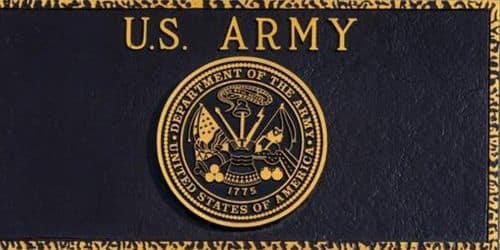The Army Seal is the official symbol of the United States Department of the Army. In 1947, when it became official, there was a change in the emblem from the “War Office Seal,” which was first made in 1778. This article talks about the WW2 US Army logo and also talks about the US recruit Army rank, salary, and requirements.
What Is the U.S. Army Logo?
The U.S. Army is a powerful military force that protects and serves the country on land, sea, and air. The Army Rangers and Special Forces are two elite groups that train a lot for high-stakes battles.
Symbolism. The Roman cuirass is the most important part of the seal and emblem. It shows strength and safety. The Army usually uses swords, espontons (a half-pike used by lower-ranking commanders), muskets, bayonets, cannons, cannonballs, mortars, and mortar bombs.
Flag of the Army
In 1956, when the Army was the only branch of the military without a standard flag, it was chosen. On June 14 of that year, the flag of the US Army was shown to the public for the first time. The original War Office seal is shown in blue above the red scroll that says “United States Army.” The year the Army was started, 1775, is also shown in blue at the bottom of the white flag.
“This We’ll Defend” is the slogan of the United States Army. It is at the top of the War Office seal and is guarded by a rattlesnake, which was a common symbol in early American culture. The strength of the US Army and its duty to protect America are shown by a Roman cuirass in the middle of the seal. The cannon and mortar on either side of the cuirass represent the strength of the United States Army. The Phrygian hat held high by an unsheathed sword represents freedom and the Army’s readiness to defend the United States of America at any time.
Its History
The US military consists of eight different parts, and the US Army is one of them. The United States Army is the first and main military force. It began as the Continental Army in 1775, during the American Revolutionary War. After the American Revolution, the Continental Army was broken up and replaced by the Congress of the Confederation, which later became the modern U.S. Army. This meant that it took its place as the official and chronological continuation of the original. Its headquarters are at the Virginia State Pentagon.
The Latin words “E PLURIBUS UNUM” are written on a long, flapping gold ribbon that the bird is holding in its beak. The wings are spread out as if to show how big the safe zone is. The eagle’s strong claws are holding thirteen silver arrows and a branch of a laurel tree with leaves and fruit on it. At its tail, between them, the powerful amulet of American soil is on display.
On the bird’s body, just below the white headline, you can see the state’s flag. In addition, its wide blue stripe is at the top, while its narrow white-red stripes are at the bottom. The stars that represent the states are grouped in a flower-shaped, coiled circle above the eagle’s head. They are set against a blue background with a gold border and a white border.
More Information
The whole thing is built on a single green circle with a yellow edge. On a wide black stripe that comes next, the words “United States” and “Army” are separated by eight five-pointed stars, four on each side. In the next step, you draw a stroke with three lines: one thin (inner) line and two middle lines (outer).
The new US Army logo came out in 2001 and caught on quickly. The order came from Leo Burnett Worldwide, a well-known advertising company.
In the middle of the black triangle, there is a yellow and black outline around a white star. It is a rectangle with spherical corners and a yellow border that duplicates all the way around in black. In the white rectangle at the bottom of the page, you can read the letters “USARMY.” Big, white, broken-up capital letters. U, S, and R all have corners that are square, which makes them look like shapes. The background and edge of the writing are the same color, just like the star.
Its Emblem
The US Army also has its own official logo and seal. The Department of the US Army Logo emblem keeps track of how these parts change over time.
Since 1974, when the current seal and insignia were made public, they have become a symbol of the United States Army and a source of pride for the country. But they were originally made to check the authenticity of papers, not as a way to advertise. It was strictly forbidden to apply again.
The US Army logo emblem comes from the Army seal, but there are a few important differences. These include the use of color and the fact that the seal says “Department of the Army” instead of “War Office.” The American flag has been put on the symbol to the right (observers’ left), which is how it is usually shown today. On the alternate flag, there are now Army symbols. In honor of the Army’s founding year, the emblem has the number 1775 instead of the Roman numerals “MDCCLXXVIII,” which show the date the Army’s seal took off.
Color
The color blue has come to mean steadfastness, loyalty, truth, and alertness. The color red represents bravery, determination, and passion. “White” stands for accomplishments worth celebrating. Most of what the Army wears is black, which is a sign of its unwavering resolve and consistency. Lastly, the gold represents the branch’s accomplishments, respect, and prestige
There would be changes in the 1990s. On came the black stars. The traditional white star was losing its luster. Charcoal, saltpeter, and sulfur are the three colors that represent the history of the US Army and the parts of gunpowder.
Its Symbol
Both of these symbols use black and gold, which are the Army’s traditional colors. Both the star insignia and the seal have these colors, along with white and a very pale blue.
The Goals of the United States Army
The U.S. Army serves the American people, defends the country, and protects national interests. They have to make sure that combatant commanders always have the right troops and skills for national security and defense plans.
Army soldiers play a significant part in team and unit operations like fast, long combat, and land stability operations. In addition to its principal function, the Army provides logistical and support services to the other military and helps civilian authorities in emergencies.
The Army is still giving combatant commanders a wide range of assets and skills so that we can win the war on terror, meet our international obligations, and build strong international coalitions. The Army’s contributions include not only helping in the War on Terror but also:
- Protection of a number of close allies and partners, including South Korea and Japan
- The mission of Keeping Peace
- Our country’s border protection
- To stop the spread of illegal drugs, we have put in place the following procedures and equipment.
The Army Force Benefits
One of the many benefits of joining the Army is that the pay can keep up with the competition. A soldier’s basic benefits include being able to get medical care, a place to live, and food. The Army also has the opportunity to continue their education. The Blended Retirement System gives people who have served less than 20 years of active duty options for their retirement pay, such as a guaranteed monthly pension or lump sum after 20 years of active duty (or age 60 for Guard and Reserve) (please speak to your recruiter for more information).
Army jobs include aviation, cyber, IT, healthcare, aircraft repair, Special Forces, etc. Excellent training and experience will equip you for any career opportunity, no matter your focus.
What Are the 4 Types of Army?
The Department of Defense is the main organization of the United States Armed Forces (DOD). The Secretary of Defense is a civilian who runs the DOD.
WW2 Us Army Logo
During WW2, the Us Army used the white stars logo to mark their vehicles. In WW2, the key symbol logo of the US Army that was first used in 1775 is based on the classic roundel shape. Its shape has stayed the same for generations. It has a central section surrounded by a circle and a wide strip with the names of the organizations and the year they started. Its mascot is the bald eagle, and its most famous historical figure is right in the middle of its seal.
Soon after the Japanese attacked Pearl Harbor in December 1941, the United States officially entered World War II. About 11 million Americans were to take part in various Army missions. The United States Army was an important part of the forces that invaded French North Africa, took over Tunisia, advanced to Sicily, and then fought in Italy. Millions of U.S. Army soldiers were essential to the success of the D-Day landings in June 1944 in northern France, which led to the liberation of Europe and the eventual defeat of Nazi Germany.
During World War II (WW2), the US Army and the US Marine Corps logo worked together to free the Pacific Islands from Japanese rule. Armed forces were sent to Japan and Germany after the Axis powers surrendered in May (Germany) and August (Japan) of 1945. When the Army Air Forces broke up in September 1947, two years after World War II, the United States Air Force was formed. In 1948, President Harry S. Truman signed Presidential Order 9981, which ended segregation in the military.
Us Army Recruit
Since the early days of the American colonies in the 1700s, the US Army has had a dedicated team to recruit individuals. However, all four branches of the armed forces (Army, Navy, Marines, and Air Force) now have hundreds of recruitment offices all over the United States. Usually, an E-5 to E-7 recruiting office will have anywhere from two to eight recruiters on staff. When a potential employee goes to a recruiting station, they go through a series of checks, including measurements, a weight check, and a history question. They also give a mock ASVAB and fingerprint scan. Applicants cannot take their oath of service at the recruiting office. This takes place at a MEPS (Military Entry Processing Station) (MEPS).
The vast majority of people who join state military forces or other armed groups are men. Internationally, the number of women working ranges from around 16% in the U.S. to somewhere in the low 20%s in other countries.
Many countries still don’t let women serve in roles that require them to kill an opponent up close, but some have changed their policies in recent years.
Studies done in Britain, Canada, and the United States show that female military members are much more likely to face sexual harassment or hurt than male military members or civilian women.
Although this change has been faced with both political and cultural resistance, certain countries, such as the United Kingdom, the United States (US), and Canada, have begun to recognize the right of transgender people to openly serve or freely recruit them in the armed forces (Army).
Methods of Recruiting for the American War Effort
Before the U.S. entered World War I, each state was responsible for its own military recruitment drives. But when the US joined the war, the federal government became more important.
During World War I, there was a big change in recruition. This was because the war put a lot more emphasis on a national effort. Peter A. Padilla and Mary Riege Laner say that recruitment ads appeal to patriotism, work or education, adventure, social status, travel, and other things. 42% of army recruitment posters between 1915 and 1918 were patriotic. Even though adventure and social status were more important, the call to duty was the best way to get people to join the military during WWII.
Strategy to Recruit in the Us Army
Building a strong workforce which includes cold calling, email marketing campaigns, and phone prospecting using lists. Prospecting is most effective by phone, but the best way is to meet with potential clients in person. At amusement parks, arenas, and other tourist spots, it’s common to see booths with military recruiters working them.
Us Army Rank
There are different levels of enlisted soldiers in the Army. These Army levels are in three groups: junior enlisted (E-1 to E-4), noncommissioned officers (NCOs) (E-4 to E-6), and senior NCOs (E-7 and higher) (E-7 through E-9).
Lower-Ranking Army Soldiers (E-1 to E-3)
Lower-ranking Army privates and specialists are automatically promoted after a specific time. After six months of service, an E-1 private becomes a PV2, and a PFC after 12 months and four months. Soldiers must serve two years and complete a technical training before moving to the next position.
Private (E-1)
A Private is the lowest rank in the Army. This rank is usually exclusively for new recruits during BCT, but sometimes it can come as a punishment. A private (E-1) in the Army does not have the right to wear any special symbols on his or her uniform.
The Second-Class Private (E-2)
After Basic Combat Training (BCT), most enlisted soldiers can become Private 2nd Class (PV2). The private’s job is to use the skills and knowledge he or she learned in basic training and to practice listening to orders from higher-ups.
Exceptional First-Class Privacy (E-3)
Private first classes (PFC) make up most of the ranks and most of the force in the U.S. Army. However, when a junior enlisted soldier gets the rank of PFC, he or she starts to learn the technical skills and leadership skills needed to move from apprentice to journeyman.
Army Sargent Major (E-4)
A Specialist (SPC) is one of the lower positions in the U.S. Army. The specialist is not an NCO, even though he has a higher rank than an E-3 private and makes the same amount as a corporal.
The specialist’s duties are more technical, and they usually have less to do with leading people than a corporal would. When they join the military, their pay usually goes up to the E-4 level. Enlistees who have finished a bachelor’s degree program or have other civilian experience and/or training that makes them qualified for a specialist entry into BCT.
Corporal (E-4)
When the Army and NCO Corps began in 1775, the rank of corporal was one of the first existing positions. The corporal rank is one of only two in the NCO Corps that has never been removed. The other is the sergeant rank.
However, the position of corporal at the bottom of the non-commissioned officer ranks has been the same throughout history. Traditionally, army corporals were in charge of leading smaller units, usually teams.
Sergeant (E-5)
Sergeants (SGT) do work where the axe literally hits the stone, making sparks fly. A Sergeant is the first step toward leadership for an enlisted individual. He or she may affect lower-ranking NCOs. Sergeants are the first NCOs privates report to.
Staff Sergeant (E-6)
A staff sergeant’s duties are very similar to those of a sergeant. Even though this level of NCO has the same basic tasks and duties as lower ranks, it is very different.
Sergeant “Platoon” or “First Class” (E-7)
To become a senior NCO, you must reach the rank of SFC. The platoon sergeant or sergeant first class has 15–18 years of experience in the military and is responsible for making quick, right decisions that help the mission and the soldier.
Master Sergeant (E-8)
The master sergeant is the highest-ranking non-commissioned officer at the battalion level and above. They don’t have as much power as a first sergeant, but they still have to lead and take care of other responsibilities well.
The First Sergeant (E-8)
Talking about the first sergeant is like talking about the Army itself. When a 1SG does a good job, the rest of their unit rises to the same level. Instead of the standard sign of power seen here, maybe their insignia would be a better choice as the main focus. In the end, the first sergeant will get to know everything the unit does. However, the first sergeant is in charge of leading formations, keeping an eye on the platoon sergeants, giving advice to the commander, and helping to train all enlisted people.
Sergeant Major (E-9)
In command positions above the battalion level, the sergeant major is the most important non-commissioned officer. Even though the sergeant major has the same skills and knowledge as the command sergeant major, he or she usually only has authority over those who are directly under their or command.
Command Sergeant Major (E-9)
Those troops who make it to the top and have the legal right to take part in the command sergeant major program are at the top of their game. In the Army, the rank of sergeant major is the highest honor for a soldier in the ranks.
The CSM is in charge of making sure that all the soldiers work, learn, look, and act according to the legal rules and standards. When it comes to local NCO support, the commander and staff go to the command sergeant major for advice and suggestions.
Sergeant Major of the Army (E-9S)
However, only one person can hold the rank of sergeant major in the Army (SMA). The holder of this job is usually the most influential person in the Army. However, an important part of the SMA’s job is to speak up for the needs of enlisted personnel at the highest levels of the Army. The SMA is the most senior enlisted advisor to the Army Chief of Staff. They also have the same respect and honor as any other enlisted member of the military.
US Army Requirements
In order to meet the requirements to join the Army, you must be between the ages of 18 and 34. (17 with parental consent). Either you have to be a citizen of the United States or a permanent resident. High school graduation is a requirement, but they can still accept a General Equivalency Diploma (GED). You also have to take the Armed Services Vocational Aptitude Battery test and a test to see how fit you are. For some jobs, you may need to meet more requirements.
Before they can join the Army, recruits must go through 10 weeks of basic training, also called “boot camp.” College students can become officers in the Army if they meet the requirements. However, they can do this by joining the Reserve Officers’ Training Corps (ROTC) at their school or by going to one of the many military academies around the country.
Here are the US Army logo requirements you must meet to join the military:
- You must be a citizen of the United States or live there permanently.
- Have at least 17 years of age. Seventeen-year-olds need permission from their parents to drink legally.
- done everything needed to get a high school diploma.
- Don’t let more than two people live with you.
- Prepare for the Armed Services Vocational Aptitude Battery (ASVAB) test and pass it.
- Do a physical exam at a Military Entrance Processing Center (MEPSC).
What is the U.S. Army Average Salary?
The average pay in the U.S. Army is between $24,998 and $88,615 for a Corporal and a Sergeant Major, respectively. On average, a Corporal in the U.S. Army makes about $1,500 a month, while a Commander makes about $7,600 a month.
The salaries in the US Army range from $60,832 to $78,580 per year, with an average of $69,099 per year. Each person’s salary range will depend on their position, division, region, experience, and education, so it’s natural that it will be different for each person. Please click on this link for more information.
Why Does the Army Have a Star Logo?
The star logo indicates the white star that was on US military (army) vehicles during World War II. However, the colors in the US Army logo stand for the three things that make up gunpowder: saltpeter (white), sulfur (yellow), and charcoal (black). A strong military group.
Can I Use a Military Logo?
The military takes legal action against anyone who uses these “military service marks” without permission. This includes military emblems, coats of arms, initials, symbols, and other identifiers. There is a chance that they protect some phrases and acronyms the military uses to indicate permission.
What is the U.S. Army Motto?
Since the US Army logo was the first military group in the country, its slogan has deep roots in the history of service in the country. During the American Revolution, in 1778, the War Office of the Continental Army used the slogan “This We’ll Defend” for the first time.
What are Military Logos Called?
Even though this didn’t happen until the 20th century, the United States military now uses chevrons to tell the difference between the ground and marine forces and the air force, navy, and coast guard. Adding rockers, or arcs, to chevrons, also shows a higher rank.
Is the U.S. a Strong Army?
The United States Army is the most powerful military force in the world. It has almost 1.5 million soldiers and a budget of $700 billion. It is on every continent to show the world how strong the United States is and to help manage emergencies at home when there are natural disasters or national crises.
How Large is the U.S. Military?
The US Army has the most people on active duty. The Navy and the Air Force are next. In 2021, the U.S. military will have over 1.4 million people, but China will have a lot more troops on the ground.
How Many Soldiers Are in the US Army?
So, the Army kept its active-duty and reserve personnel complements pretty much the same size as they were in FY 2021. These are the goals for FY 2022: There are 485,000 people in the regular Army, 336,000 in the National Guard, and 189,500 in the Army Reserve.
How Strong is NATO?
Statista says that there are now more than 5.4 million people in the military who work for NATO, which is about four times as many as Russia. Its armed forces have about five times as many planes, four times as many tanks, and three times as many warships.
Whose Army is Stronger, the USA or Russia?
In terms of military power, the United States is number one and Russia is number two. The United States has 334,998,398 soldiers, while Russia has 142,320,790. There are 147,399,295 people in the United States and 69,737,187 people in Russia.
Summary
The history of the traditional US Army logo emblem goes back to the American Revolution (1775–1783). It was made to be a “seal” that they could put on important documents. Most history books agree that the first time the US Army seal was used was sometime in 1778, but they can’t say exactly when. The Army has bases all over the world, such as in Asia, Europe, the Middle East, and Africa. When there is a war, they will send troops there. The United States Army organizes, trains, and equips both regular and reserve forces to keep the country safe and secure and to protect it from threats from outside.
Related Articles
- Swiss Watch Brands: Top Affordable Swiss, Updated (+Detailed Guide)
- California Small Business Grants: Top 13+ picks for Minorities & Veterans (+ Application Guide)
- Financial Investment: Best Guide for Optimal results(+ Detailed Courses)
- Contingent Beneficiary: Definition, Characteristics & all you should know
- SEO Management Tools: Meaning, Free, and Best SEO Tools [2023]






